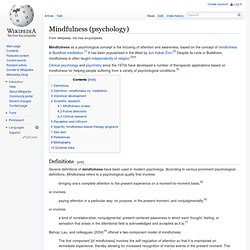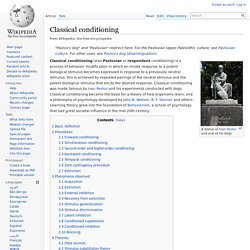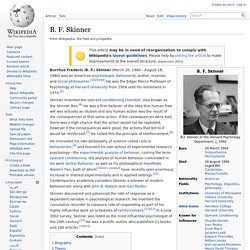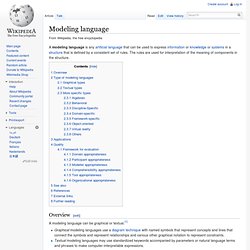Behaviorism
> Psychology, Philosophy, Thinking
> Psychology
Mindfulness (psychology)
Mindfulness as a psychological concept is the focusing of attention and awareness, based on the concept of mindfulness in Buddhist meditation.[1] It has been popularised in the West by Jon Kabat-Zinn.[2] Despite its roots in Buddhism, mindfulness is often taught independently of religion.[3][4] Clinical psychology and psychiatry since the 1970s have developed a number of therapeutic applications based on mindfulness for helping people suffering from a variety of psychological conditions.[5] Several definitions of mindfulness have been used in modern psychology.

According to various prominent psychological definitions, Mindfulness refers to a psychological quality that involves bringing one’s complete attention to the present experience on a moment-to-moment basis,[6] or involves paying attention in a particular way: on purpose, in the present moment, and nonjudgmentally,[6]
47 Mind-Blowing Psychology-Proven Facts You Should Know About Yourself. 7 Secrets of the Super Organized. A few years ago, my life was a mess.

So was my house, my desk, my mind. Then I learned, one by one, a few habits that got me completely organized. Am I perfect? Of course not, and I don’t aim to be. But I know where everything is, I know what I need to do today, I don’t forget things most of the time, and my house is uncluttered and relatively clean (well, as clean as you can get when you have toddlers and big kids running around).
50 Tricks to Get Things Done Faster, Better, and More Easily. Visual Thinking. Behavioral Pattern Analysis. Requirements are descriptions of the application domain, the problems to be solved there, and the system(s) to be built in that domain to solve these problems.

Many projects have failed because their requirements were inadequately explored or described. Experience is beginning to show several problems with Use cases such as lack of a precise definition that led most companies to re-invent their own version, lack of notion of atomicity, and considering only the users interface.A new alternative modeling approach presented in this paper, Behavioral Pattern Analysis (BPA), is an Event-Oriented approach in which events are considered the primary entities of the world model. The appeal to events is natural. The creation of an Object is an Event.
Should we not define the requirements of the model that we are building in terms of events?
Behaviourism. If you want to follow your own links, use "behaviorism" (sic.)

Most of the material is US-based and "behaviorism" and "behaviorist" is how they spell it, and I freely admit that this side-bar is purely to get the stupid search engine "bots" to register "behavior" Behavioural (or "behavioral") theory in psychology is a very substantial field: follow the links to the left or right for introductions to some of its more detailed contributions impinging on how people learn in the real world.
How I have the effrontery to produce a single page on it amazes even me, whatever my reservations about it! Behaviourism is primarily associated with Pavlov (classical conditioning) in Russia and with Thorndike, Watson and particularly Skinner in the United States (operant conditioning).
Behaviorism (Wikipedia)
Behaviorism (or behaviourism), is the science of behavior that focuses on observable behavior only,[1] it is also an approach to psychology that combines elements of philosophy, methodology, and theory.[2] It emerged in the early twentieth century as a reaction to "mentalistic" psychology, which often had difficulty making predictions that could be tested using rigorous experimental methods.

The primary tenet of behaviorism, as expressed in the writings of John B. Watson, B. F. Skinner, and others, is that psychology should concern itself with the observable behavior of people and animals, not with unobservable events that take place in their minds.[3] The behaviorist school of thought maintains that behaviors as such can be described scientifically without recourse either to internal physiological events or to hypothetical constructs such as thoughts and beliefs.[4] Versions[edit]
Ivan Pavlov. Ivan Petrovich Pavlov (Russian: Ива́н Петро́вич Па́влов, IPA: [ɪˈvan pʲɪˈtrovʲɪt͡ɕ ˈpavləf] ( ); 26 September [O.S. 14 September] 1849 – 27 February 1936) was a Russian physiologist known primarily for his work in classical conditioning.

From his childhood days Pavlov demonstrated intellectual brilliance along with an unusual energy which he named "the instinct for research".[1] Inspired by the progressive ideas which D. I. Pisarev, the most eminent of the Russian literary critics of the 1860s and I. M. Early life and schooling[edit] The Pavlov Memorial Museum, Ryazan: Pavlov's former home, built in the early 19th century[5]
Classical conditioning. Classical conditioning (also Pavlovian or respondent conditioning) is a process of behavior modification in which an innate response to a potent biological stimulus becomes expressed in response to a previously neutral stimulus; this is achieved by repeated pairings of the neutral stimulus and the potent biological stimulus that elicits the desired response.

Classical conditioning was made famous by Ivan Pavlov and his experiments conducted with dogs. Classical conditioning became the basis for a theory of how organisms learn, and a philosophy of psychology developed by John B. Watson, B. F. Skinner and others. Basic Definition[edit]
Richard Herrnstein. Richard J.

Herrnstein (May 20, 1930 – September 13, 1994) was an American researcher in animal learning in the Skinnerian tradition. He was one of the founders of quantitative analysis of behavior. His major research finding as an experimental psychologist is called "matching law"—the tendency of animals to allocate their choices in direct proportion to the rewards they provide. To illustrate the phenomenon, imagine that there are two sources of reward, one of which is twice as rich as the other.
B. F. Skinner. Burrhus Frederic (B.

F.) Skinner (March 20, 1904 – August 18, 1990) was an American psychologist, behaviorist, author, inventor, and social philosopher.[1][2][3][4] He was the Edgar Pierce Professor of Psychology at Harvard University from 1958 until his retirement in 1974.[5] Skinner invented the operant conditioning chamber, also known as the Skinner Box.[6] He was a firm believer of the idea that human free will was actually an illusion and any human action was the result of the consequences of that same action.
If the consequences were bad, there was a high chance that the action would not be repeated; however if the consequences were good, the actions that led to it would be reinforced.[7] He called this the principle of reinforcement.[8] He innovated his own philosophy of science called radical behaviorism,[9] and founded his own school of experimental research psychology—the experimental analysis of behavior, coining the term operant conditioning.
Biography[edit]
Modeling language (Wikipedia)
A modeling language is any artificial language that can be used to express information or knowledge or systems in a structure that is defined by a consistent set of rules.

The rules are used for interpretation of the meaning of components in the structure. Overview[edit] A modeling language can be graphical or textual.[1] Graphical modeling languages use a diagram technique with named symbols that represent concepts and lines that connect the symbols and represent relationships and various other graphical notation to represent constraints.Textual modeling languages may use standardized keywords accompanied by parameters or natural language terms and phrases to make computer-interpretable expressions.
Not all modeling languages are executable, and for those that are, the use of them doesn't necessarily mean that programmers are no longer required.
Micro Expressions - Research, Theory & Lying. Interesting Info -> Lying Index & Body Language -> Micro Expressions Is the show "Lie to Me" for real? I am not a police interrogator, scientist, or other expert... I am however a mother & people watcher. Years ago, when I wrote articles on How to Detect Lies & Eye Movement and Lying -- I knew of the Micro expression theory, but had a difficult time researching the subject well enough to relay it into an article.
Recently, I've come across tons of new research, websites, articles, videos, etc. about micro expressions and believe anyone who reads my old articles about lying & body language would benefit from micro expression research and theory.
Eye Movement and Lying - How to detect lies. Interesting Info -> Lying Index -> Eye Direction & Visual Accessing Cues Eye Movement and Direction & How it Can Reveal Truth or Lies This is a continuation of our previous article Detecting Lies. Many comments by our visitors asked about how eye direction can indicate the presence of a lie. Can the direction a person's eyes reveal whether or not they are making a truthful statement?
Short answer: sort of.
Body Language and Flirting - Blifaloo. Interesting Info -> Body Language -> Flirting Body Language (part 1) Quick Jump: General Signs of Flirting | Male Flirting | Female Flirting Also See: Body Language Resources | Decoding Male Body Language Updated March 21st - 2012. New resources, information, books and links added.
How to Detect Lies - body language, reactions, speech patterns.










